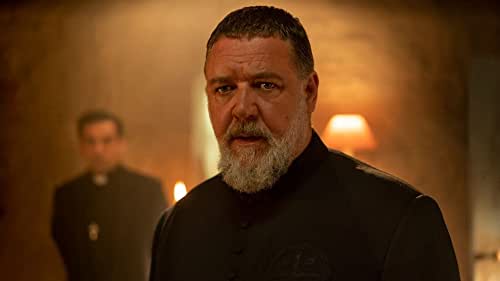In Russell Crowe’s second role as a Roman superhero, he moves from the 2nd century as Maximus, a gladiator who does battle for the emperor’s entertainment (“The Gladiator” 2000), to the 21st century as the Catholic priest Fr Gabriel Amorth, who fights the devil with a bit of help in the newly released “The Pope’s Exorcist.” (To be fair, Crowe also played Superman’s father, Jor-El, in 2013 in “Man of Steel,” but he didn’t quite reach superhero status like his son).
Some background
Fr Gabriel Amorth, SSP, 1925-2016, was an Italian priest who fought as a partisan soldier against the Germans during World War II; he was counseled by St Padre Pio and Blessed James Alberione, who accepted him into the Society of St. Paul, a congregation dedicated to using the communications media to spread God’s Word. Amorth was ordained in 1954 and carried out many roles in the congregation. He found his niche when he was assigned to write for the Italian magazines published by the Pauline Fathers, La Famiglia Cristiana, and Madre di Dio. He was an expert in Mariology and was a frequent guest on Radio Maria in Italy.
In 1986 he was asked to become an exorcist for the Diocese of Rome by Cardinal Ugo Poletti, the Vicar General of Rome (the Pope is the Bishop of Rome). He learned the rite of exorcism from a Passionist priest. Fr. Candido Amantini.
Fr. Amorth wrote many books, two of which form the basis for The Pope’s Exorcist: An Exorcist Tells His Story (1990) and An Exorcist: More Stories (1993.) These influential books tell the priest’s story and also explain exorcisms. In 2017 director William Friedkin (The Exorcist; 1973) released a documentary, The Devil and Father Amorth, where he follows the exorcist on his rounds. (I reviewed it then in the National Catholic Reporter). Fr Amorth died in 2016. It is good to know that although he was controversial to some and somewhat of a “character,” he lived and died a priest in good standing.
I feel this background knowledge clarifies the story of “The Pope’s Exorcist.” Although this title does not exist, the pope, played by Franco Neri, was technically Fr. Amorth’s boss. One of the film’s conceits is that it gives Amorth more clerical status than he had.
It is important to recall that “The Pope’s Exorcist” is not a documentary but a “historical thriller” or “horror” film. It is based on two books written by the main character, Fr. Gabriel Amorth. The film does a good job, I think, of portraying his persona while the surrounding story is fictional with some ties to reality.
My review
The film opens with a dramatic exorcism with Fr. Amorth called in to exorcize a person and does so by sending the demon into a pig (reminiscent of Matthew 8:32) that someone then shoots. Next, Amorth heads to the Vatican on his Vespa motor scooter because he has been called there to answer to a panel of hierarchs led by the very young Cardinal Sullivan (Ryan O’Grady), who calls into question his tendency to perform exorcisms in other dioceses without the necessary and required permission. True to form, Amorth decides the meeting is over and tells the Cardinal to talk to his boss. However, Bishop Lumumba (Cornell John) reassures Amorth that he has his back, and Amorth tells him he doesn’t need his help. Pride is always an issue in the Christian life and even Fr Amorth struggles with it.
Julia (Alex Essoe), a young American widow, is moving her moody daughter Amy (Laurel Mardsen) and young son Henry (who has not uttered a word since his father’s death; Peter DeSouza-Feighoney) into an ancient and remote Spanish abbey that Amy is converting into a hotel. Fr. Esquibel (Daniel Zovatto), the local parish priest, is on hand to welcome them. But when a suspicious fire breaks out and kills one of the workers, the contractor pulls out his crew and abandons the job. Word gets to the pope, probably because he knew through records kept in the Vatican Library that the abbey was where many people were tortured and killed during the Spanish Inquisition around 1500 AD could explain the supernatural happenings. The pope, who is unwell, tells Amorth this family needs him because it is beset by a demon.
Fr. Amorth arrives on his Vespa with his case filled with his tools of the trade. He meets Fr. Esquibel and asks him to help, giving him a Miraculous Medal of Our Lady that he believes will fend off the devil.
This is when the demonic possession of Henry is manifest, and the “fun” of this “historical thriller” begins. The exact details of the story don’t matter; this is a template diabolical possession exorcism movie using horror motifs of isolation, darkness, fear, and supernatural activity, that we have all seen before. The storyline is weakly constructed, and there is virtually no character development; there is no one that we care about – except Russell Crowe’s Fr. Amorth.
Finding the remains of Torquemada, the first grand inquisitor of the Spanish Inquisition, down a well and under the abbey’s floors was a stretch. With better writing, this theme could have made the film far more interesting than a blood and guts, rolling eyeballs, and freaky wall climbers scream fest. The comment on the clergy abuse scandal and the Vatican’s part in it (or nefarious actions goings on in the Vatican that the real-life Amorth did believe were happening) made the script more disjointed. There is a subtle bipolarity in the film’s structure: the Church as a cause of terror and the Church as the means of its own healing, with Amorth as a hero.
There are flashbacks to Amorth’s early life as a partisan soldier fighting against the Nazi invasion and occupation of Italy. Though Amorth says that the devil can get to us through our sins when he confesses to Fr. Esquibel, what he seems to reveal is regret: survivors’ guilt for not being killed when the rest of his partisan group died and then failing to help a young woman who then takes her own life.
Amorth’s wry persona can be funny here and there – and he can be solemn. His use of the sacramentals from his tool kit, as noted above, including the medal of St. Benedict, the Crucifix, holy water, the rosary, the ritual of exorcism with its invocation of God, the Virgin Mary, and casting out demons in the name of the Father, Son, and Holy Spirit, will resonate with many viewers.
Some viewers will object to Amorth conversing with the devil (something he tells Fr. Esquibel not to do!) as forbidden by the Church. Here’s what a query to AI had to say about this; I think it is accurate:
The Rite of Exorcism is a liturgical text used by the Catholic Church during the exorcism of individuals believed to be possessed by evil spirits or demons. The text contains prayers, blessings, and instructions for the exorcist to follow during the ritual.
While the Rite of Exorcism does not explicitly mention the exorcist conversing with the devil, some exorcists may choose to speak directly to the demon or ask it questions during the exorcism. However, this is not a requirement of the Rite, and many exorcists believe that engaging in conversation with the demon can be dangerous and even counterproductive to the overall goal of the exorcism.
In general, the Catholic Church emphasizes the use of prayer, scripture, and other religious sacraments during the exorcism ritual, rather than direct communication with the demon or devil. The focus is on invoking the power of God and driving out the evil spirit through faith and the sacraments of the Church.
I think the film makes it very clear that a bishop must give permission to a priest to perform exorcisms, that exorcists should be mentored and trained, and that the person that may be possessed (tempted, oppressed, obsessed, deceived) by the devil, be evaluated by a doctor and psychiatrist before the exorcism is performed. Mental illness can present as diabolical possession. Lay people, even the famous Ed and Lorraine Warren, whose story is told in the 2013 film “The Conjuring,” are not given permission to carry out exorcisms. However, people are encouraged to pray prayers of deliverance (the “Our Father” being the best one we can pray for ourselves and others.) Fr. Amorth, in real life, carried out exorcisms with a team that included a doctor, psychiatrist, and family, friends, and people who would pray for the person. In the film, during the first exorcism, Amorth asks someone to pray the “Our Father” continually; later, Amorth is assisted by Fr. Esquibel.
I am trying to recall if a Bible was evident in the film; I cannot remember. The real Fr Amorth relied on the Word of God, the sacraments and sacramentals, prayer, and avoidance of sin. How much viewers will hear, see, experience, or interpret from the film is difficult to predict – but one can hope.
If one lacuna in this film could be filled in by a sequel (the ending seems to be a setup for one), it is to show how much people tormented by the devil suffer interiorly. The film, true, is an external expression of internal realities, but this gory horror extravaganza and its lack of character development overshadow our ability to empathize with the devil’s victims. There is a fine line between entertainment and exploitation. One trusts the audience to tell the difference.
Australian director Julius Avery is still relatively new to his art, and his efforts here don’t add much to his resume (though anyone who can get a big motion picture made deserves praise – it just depends on how much.) The film’s writers are credited as veteran Michael Petroni (“The Rite” 2011) and Evan Spiliotopoulous (co-writer for the 2014 film “Hercules” and several others), both of whom hail from Australia, too. However, perhaps without knowing, they fell into the superhero mold to craft this story. Amorth is a savior, suffers for the victims, almost becomes one himself due to his flaws, and then his heroic good actions win over evil.
Also, the film has a rushed, too many cooks in the kitchen feel. If there is a next time, I hope the studio doesn’t push it through but takes the time to create a masterpiece rather than the kind of hit-and-run film that most people probably won’t see again, even with cinematography on steroids, by the established Khalid Mohtaseb who is credited as Director of Photography (DP). A cinematographer could have added a cohesive visual aesthetic to the essential efforts of the DP.
In conclusion, this is one of those films you can take or leave, though seeing it on a big screen is certainly more of an experience, shall we say. One reason to see it, however, is to know that God triumphs over evil and chaos. Another is for Russell Crowe’s steadfast performance, the ridiculous sight of him riding a Vespa in Rome, and the thought of him riding one to Spain from Italy notwithstanding. He maintains character throughout, thus making him a still point amid supernatural chaos. Though Fr. Gabriele Amorth was a controversial figure, his books have sold millions, and he is known to have helped many people.
Just this morning at breakfast, one of our older Italian sisters told me that back in the late 50s, long before he became an exorcist, Fr. Amorth significantly influenced her decision to become a religious among the Daughters of St. Paul. In those years, he visited communities of the Society of St Paul and Daughters of St Paul to encourage vocations to the priesthood and religious life.
Would Fr. Amorth be happy with this film? Perhaps. As long as people realize they must not carry out exorcisms themselves, that human beings suffer when attacked by the devil, and that the true evil of Satan and his minions are revealed so that audiences realize that messing with the devil is no joke.
Prayer for Deliverance from Evil
Immaculate Heart! Help us to conquer the menace of evil, which so easily takes root in the hearts of the people of today, and whose immeasurable effects already weigh down upon our modern world and seem to block the paths toward the future!
From famine and war, deliver us.
From nuclear war, from incalculable self-destruction, from every kind of war, deliver us.
From sins against the life of man from its very beginning, deliver us.
From hatred and from the demeaning of the dignity of the children of God, deliver us.
From every kind of injustice in the life of society, both national and international, deliver us.
From readiness to trample on the commandments of God, deliver us.
From attempts to stifle in human hearts the very truth of God, deliver us.
From the loss of awareness of good and evil, deliver us.
From sins against the Holy Spirit, deliver us, deliver us.
Accept, O Mother of Christ, this cry laden with the sufferings of all individual human beings, laden with the sufferings of whole societies.
Help us with the power of the Holy Spirit to conquer all sin: individual sin and the “sin of the world”, sin in all its manifestations.
Let there be revealed, once more, in the history of the world the infinite saving power of the Redemption: the power of merciful Love!
May it put a stop to evil!
May it transform consciences!
May your Immaculate Heart reveal for all the light of Hope!
Saint John Paul II, 1984, on the occasion of the consecration of the world to the Immaculate Heart of Mary.


